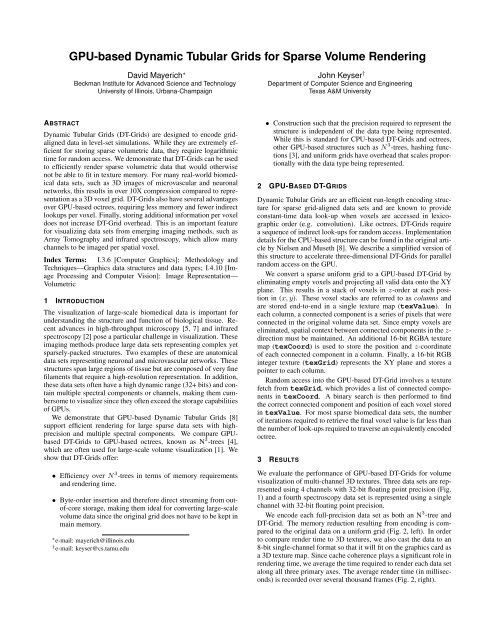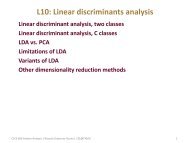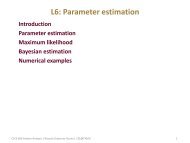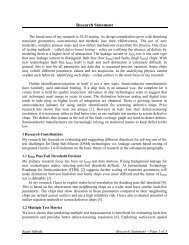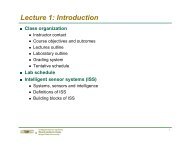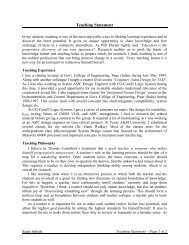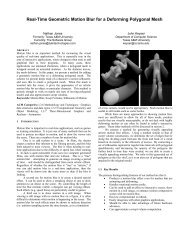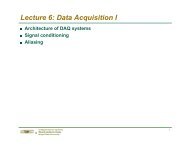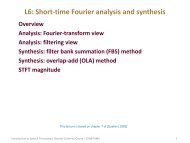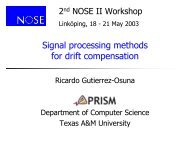GPU-based Dynamic Tubular Grids for Sparse Volume Rendering
GPU-based Dynamic Tubular Grids for Sparse Volume Rendering
GPU-based Dynamic Tubular Grids for Sparse Volume Rendering
Create successful ePaper yourself
Turn your PDF publications into a flip-book with our unique Google optimized e-Paper software.
ABSTRACT<br />
<strong>GPU</strong>-<strong>based</strong> <strong>Dynamic</strong> <strong>Tubular</strong> <strong>Grids</strong> <strong>for</strong> <strong>Sparse</strong> <strong>Volume</strong> <strong>Rendering</strong><br />
David Mayerich ∗<br />
Beckman Institute <strong>for</strong> Advanced Science and Technology<br />
University of Illinois, Urbana-Champaign<br />
<strong>Dynamic</strong> <strong>Tubular</strong> <strong>Grids</strong> (DT-<strong>Grids</strong>) are designed to encode gridaligned<br />
data in level-set simulations. While they are extremely efficient<br />
<strong>for</strong> storing sparse volumetric data, they require logarithmic<br />
time <strong>for</strong> random access. We demonstrate that DT-<strong>Grids</strong> can be used<br />
to efficiently render sparse volumetric data that would otherwise<br />
not be able to fit in texture memory. For many real-world biomedical<br />
data sets, such as 3D images of microvascular and neuronal<br />
networks, this results in over 10X compression compared to representation<br />
as a 3D voxel grid. DT-<strong>Grids</strong> also have several advantages<br />
over <strong>GPU</strong>-<strong>based</strong> octrees, requiring less memory and fewer indirect<br />
lookups per voxel. Finally, storing additional in<strong>for</strong>mation per voxel<br />
does not increase DT-Grid overhead. This is an important feature<br />
<strong>for</strong> visualizing data sets from emerging imaging methods, such as<br />
Array Tomography and infrared spectroscopy, which allow many<br />
channels to be imaged per spatial voxel.<br />
Index Terms: I.3.6 [Computer Graphics]: Methodology and<br />
Techniques—Graphics data structures and data types; I.4.10 [Image<br />
Processing and Computer Vision]: Image Representation—<br />
<strong>Volume</strong>tric<br />
1 INTRODUCTION<br />
The visualization of large-scale biomedical data is important <strong>for</strong><br />
understanding the structure and function of biological tissue. Recent<br />
advances in high-throughput microscopy [5, 7] and infrared<br />
spectroscopy [2] pose a particular challenge in visualization. These<br />
imaging methods produce large data sets representing complex yet<br />
sparsely-packed structures. Two examples of these are anatomical<br />
data sets representing neuronal and microvascular networks. These<br />
structures span large regions of tissue but are composed of very fine<br />
filaments that require a high-resolution representation. In addition,<br />
these data sets often have a high dynamic range (32+ bits) and contain<br />
multiple spectral components or channels, making them cumbersome<br />
to visualize since they often exceed the storage capabilities<br />
of <strong>GPU</strong>s.<br />
We demonstrate that <strong>GPU</strong>-<strong>based</strong> <strong>Dynamic</strong> <strong>Tubular</strong> <strong>Grids</strong> [8]<br />
support efficient rendering <strong>for</strong> large sparse data sets with highprecision<br />
and multiple spectral components. We compare <strong>GPU</strong><strong>based</strong><br />
DT-<strong>Grids</strong> to <strong>GPU</strong>-<strong>based</strong> octrees, known as N 3 -trees [4],<br />
which are often used <strong>for</strong> large-scale volume visualization [1]. We<br />
show that DT-<strong>Grids</strong> offer:<br />
• Efficiency over N 3 -trees in terms of memory requirements<br />
and rendering time.<br />
• Byte-order insertion and there<strong>for</strong>e direct streaming from outof-core<br />
storage, making them ideal <strong>for</strong> converting large-scale<br />
volume data since the original grid does not have to be kept in<br />
main memory.<br />
∗ e-mail: mayerich@illinois.edu<br />
† e-mail: keyser@cs.tamu.edu<br />
John Keyser †<br />
Department of Computer Science and Engineering<br />
Texas A&M University<br />
• Construction such that the precision required to represent the<br />
structure is independent of the data type being represented.<br />
While this is standard <strong>for</strong> CPU-<strong>based</strong> DT-<strong>Grids</strong> and octrees,<br />
other <strong>GPU</strong>-<strong>based</strong> structures such as N 3 -trees, hashing functions<br />
[3], and uni<strong>for</strong>m grids have overhead that scales proportionally<br />
with the data type being represented.<br />
2 <strong>GPU</strong>-BASED DT-GRIDS<br />
<strong>Dynamic</strong> <strong>Tubular</strong> <strong>Grids</strong> are an efficient run-length encoding structure<br />
<strong>for</strong> sparse grid-aligned data sets and are known to provide<br />
constant-time data look-up when voxels are accessed in lexicographic<br />
order (e.g. convolution). Like octrees, DT-<strong>Grids</strong> require<br />
a sequence of indirect look-ups <strong>for</strong> random access. Implementation<br />
details <strong>for</strong> the CPU-<strong>based</strong> structure can be found in the original article<br />
by Nielsen and Museth [8]. We describe a simplified version of<br />
this structure to accelerate three-dimensional DT-<strong>Grids</strong> <strong>for</strong> parallel<br />
random access on the <strong>GPU</strong>.<br />
We convert a sparse uni<strong>for</strong>m grid to a <strong>GPU</strong>-<strong>based</strong> DT-Grid by<br />
eliminating empty voxels and projecting all valid data onto the XY<br />
plane. This results in a stack of voxels in z-order at each position<br />
in (x, y). These voxel stacks are referred to as columns and<br />
are stored end-to-end in a single texture map (texValue). In<br />
each column, a connected component is a series of pixels that were<br />
connected in the original volume data set. Since empty voxels are<br />
eliminated, spatial context between connected components in the zdirection<br />
must be maintained. An additional 16-bit RGBA texture<br />
map (texCoord) is used to store the position and z-coordinate<br />
of each connected component in a column. Finally, a 16-bit RGB<br />
integer texture (texGrid) represents the XY plane and stores a<br />
pointer to each column.<br />
Random access into the <strong>GPU</strong>-<strong>based</strong> DT-Grid involves a texture<br />
fetch from texGrid, which provides a list of connected components<br />
in texCoord. A binary search is then per<strong>for</strong>med to find<br />
the correct connected component and position of each voxel stored<br />
in texValue. For most sparse biomedical data sets, the number<br />
of iterations required to retrieve the final voxel value is far less than<br />
the number of look-ups required to traverse an equivalently encoded<br />
octree.<br />
3 RESULTS<br />
We evaluate the per<strong>for</strong>mance of <strong>GPU</strong>-<strong>based</strong> DT-<strong>Grids</strong> <strong>for</strong> volume<br />
visualization of multi-channel 3D textures. Three data sets are represented<br />
using 4 channels with 32-bit floating point precision (Fig.<br />
1) and a fourth spectroscopy data set is represented using a single<br />
channel with 32-bit floating point precision.<br />
We encode each full-precision data set as both an N 3 -tree and<br />
DT-Grid. The memory reduction resulting from encoding is compared<br />
to the original data on a uni<strong>for</strong>m grid (Fig. 2, left). In order<br />
to compare render time to 3D textures, we also cast the data to an<br />
8-bit single-channel <strong>for</strong>mat so that it will fit on the graphics card as<br />
a 3D texture map. Since cache coherence plays a significant role in<br />
rendering time, we average the time required to render each data set<br />
along all three primary axes. The average render time (in milliseconds)<br />
is recorded over several thousand frames (Fig. 2, right).
Data Size (Gb)<br />
2.5<br />
2<br />
1.5<br />
1<br />
0.5<br />
0<br />
Figure 1: <strong>Volume</strong>tric data sets represented as a grid of 4 32-bit floating point values. (left) 512 3 (2.15GB) high-genus solid. (center) 512 3<br />
(2.15GB) data set of brain microvessels captured using Knife-Edge Scanning Microscopy. Blue and red channels map to vessel diameter<br />
(largest to smallest) and the green channel reflects depth from the cortical surface. (right) 781x687x268 (2.3GB) grid of neurons imaged using<br />
Array Tomography. Each channel represents the density of a different protein at that voxel location. Green voxels represent a subset of neuronal<br />
fibers, blue voxels represent DNA, and red voxels represent protein density at synaptic junctions.<br />
High Genus Vessels AT Breast<br />
Data Set<br />
Uni<strong>for</strong>m<br />
N³-Tree<br />
DT-Grid<br />
FPS<br />
40<br />
35<br />
30<br />
25<br />
20<br />
15<br />
10<br />
5<br />
0<br />
High Genus KESM Vessels Array Tomography Aneurysm Backpack Colon Phantom<br />
Figure 2: (left) Reduction in data set size using N 3 -trees and DT-<strong>Grids</strong> to eliminate empty space. (right) Average time required to render all<br />
voxels in three volumetric data sets (Fig. 1) and a 600x300x1641 spectroscopy image of a breast biopsy. Speedup over N 3 -trees is obtained<br />
through greater cache coherence along two axes. When visualization is constrained to these two axes, rendering time becomes competitive with<br />
3D texture maps. The spectroscopy image is an orthographic projection along one axis, there<strong>for</strong>e only the constrained time is presented.<br />
4 CONCLUSION<br />
The rendering time <strong>for</strong> DT-<strong>Grids</strong> is significantly lower than N 3 -<br />
trees as a result of both (a) fewer texture fetches required to evaluate<br />
the final fragment color and (b) a greater percentage of coherent<br />
and sequential texture fetches. The rendering time <strong>for</strong> 3D texture<br />
maps is larger along the x-axis while DT-<strong>Grids</strong> take longer to render<br />
along the encoding axis. This is due to incoherent texture fetches<br />
inherent in slice-<strong>based</strong> volume rendering. Methods <strong>for</strong> smoothing<br />
the frame rate have been reported previously in the literature <strong>for</strong><br />
uni<strong>for</strong>m grids [9] and are applicable to DT-<strong>Grids</strong>. However, constraining<br />
rendering to the two most efficient axes provides per<strong>for</strong>mance<br />
comparable to uni<strong>for</strong>m grids <strong>for</strong> data that is too large to fit<br />
on the graphics card as a 3D texture map. DT-<strong>Grids</strong> allow additional<br />
data elements to be stored per-voxel without increasing the<br />
required overhead. Additional channels can be used to store in<strong>for</strong>mation<br />
such as lighting, time-dependent functions, and identifiers<br />
<strong>for</strong> use in selective visualization [6].<br />
ACKNOWLEDGEMENTS<br />
The authors wish to thank Brad Busse, Steven Smith, Michael<br />
Walsh, and Rohit Bhargava <strong>for</strong> their biomedical data. This work<br />
was supported in part by NIH/NINDS grant #R01-NS54252 and<br />
the Beckman Institute <strong>for</strong> Advanced Science and Technology.<br />
REFERENCES<br />
[1] C. Crassin, F. Neyret, S. Lefebvre, and E. Eisemann. GigaVoxels :<br />
Ray-Guided streaming <strong>for</strong> efficient and detailed voxel rendering. In<br />
ACM SIGGRAPH Symposium on Interactive 3D Graphics and Games<br />
(I3D). Feb. 2009.<br />
[2] D. C. Fernandez, R. Bhargava, S. M. Hewitt, and I. W. Levin. Infrared<br />
spectroscopic imaging <strong>for</strong> histopathologic recognition. Nature Biotechnology,<br />
23(4):469–474, Apr. 2005.<br />
[3] S. Lefebvre and H. Hoppe. Perfect spatial hashing. ACM Transactions<br />
on Graphics, 25(3):588, 2006.<br />
[4] S. Lefebvre, S. Hornus, and F. Neyret. Octree textures on the <strong>GPU</strong>.<br />
<strong>GPU</strong> Gems 2, pages 595–613, 2005.<br />
[5] D. Mayerich, L. C. Abbott, and B. H. McCormick. Knife-Edge scanning<br />
microscopy <strong>for</strong> imaging and reconstruction of Three-Dimensional<br />
anatomical structures of the mouse brain. Journal of Microscopy,<br />
231(1):134–143, July 2008.<br />
[6] D. Mayerich and J. Keyser. Visualization of cellular and microvascular<br />
relationships. IEEE Transactions on Visualization and Computer<br />
Graphics, 14(6):1611–1618, Dec. 2008.<br />
[7] K. D. Micheva and S. J. Smith. Array tomography: A new tool <strong>for</strong><br />
imaging the molecular architecture and ultrastructure of neural circuits.<br />
Neuron, 55:25–36, 2007.<br />
[8] M. Nielsen and K. Museth. <strong>Dynamic</strong> tubular grid: An efficient data<br />
structure and algorithms <strong>for</strong> high resolution level sets. Journal of Scientific<br />
Computing, 26:261–299, 2006.<br />
[9] D. Weiskopf, M. Weiler, and T. Ertl. Maintaining constant frame rates<br />
in 3D texture-<strong>based</strong> volume rendering. In Computer Graphics International,<br />
2004. Proceedings, pages 604–607, 2004.<br />
N³<br />
DT-Gri<br />
3D Tex


